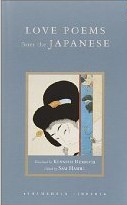 Index of Poetry.
Index of Poetry.
 Highlights for Poetry.
Highlights for Poetry.
 Books of Poetry Form.
Books of Poetry Form.
 How to Write Poetry.
How to Write Poetry.
 Latest books read.
Latest books read.
 Haibun.
Haibun.
 Haiga.
Haiga.
 Haiku.
Haiku.
 Hay(na)ku.
Hay(na)ku.
 Rengay.
Rengay.
 Renku.
Renku.
 Tanka.
Tanka.
 Tan-renga.
Tan-renga.
 Cinquain.
Cinquain.
 Concrete.
Concrete.
 Fib.
Fib.
 Ghazal.
Ghazal.
 Lai.
Lai.
 Pantoum.
Pantoum.
 Prose poem.
Prose poem.
 Rondeau.
Rondeau.
 Rubáiyát.
Rubáiyát.
 Sestina.
Sestina.
 Skaldic verse.
Skaldic verse.
 Sonnet.
Sonnet.
 Terza rima.
Terza rima.
 Triolet.
Triolet.
 Tritina.
Tritina.
 Villanelle.
Villanelle.
 El Poema Concreto.
El Poema Concreto.
 Haiku by Bashō.
Haiku by Bashō.
 Haiku by Shiki.
Haiku by Shiki.
 Haiku by J. Zimmerman.
Haiku by J. Zimmerman.
 Tanka by J. Zimmerman.
Tanka by J. Zimmerman.
 Ueda on Tanka.
Ueda on Tanka.


| Modern Japanese Tanka
edited by Makoto Ueda.
The 'first collection' of modern Japanese tanka available in English. A delightful and comprehensive presentation that shows the development of the tanka form. |

|
Writing and Enjoying Haiku: A Hands-On Guide (2003)
by Jane Reichhold, whose many skills include a keen sense for the writing and appreciation of haiku. This book includes useful guidelines on writing haiku and related forms. |

|
Love Poems from the Japanese (1994)
translated by Kenneth Rexroth edited by Sam Hamill, with selections from four books of Rexroth's translations: One Hundred Poems from the Japanese, One Hundred More Poems from the Japanese, The Burning Heart, and Love Poems of Marichiko. Some of the greatest love poems from the Japanese tradition selected from classical (including the imperial Manyoshu and Kokinshu), medieval, and modern sources. |